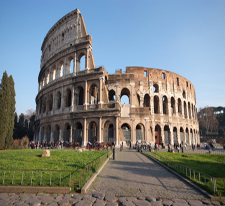Going Green With Concrete
 There has always been water content in concrete. In fact, concrete strength and durability is partially defined by the proportion of moisture content to cement. Quarries blast limestone and grind it with clay to create cement, concrete’s binding agent. Manufacturers mix cement powder with water, and the resulting calcium-silicate-hydrate bonds other particulates, like sand or gravel, to make the concrete on which billions of humans tread.
There has always been water content in concrete. In fact, concrete strength and durability is partially defined by the proportion of moisture content to cement. Quarries blast limestone and grind it with clay to create cement, concrete’s binding agent. Manufacturers mix cement powder with water, and the resulting calcium-silicate-hydrate bonds other particulates, like sand or gravel, to make the concrete on which billions of humans tread.
The world’s concrete production volume is an environmental concern. According to the Cement Sustainability Initiative Report, concrete production has almost quadrupled since 1970. Humans produce approximately 2.35 billion tons of concrete annually. The World Wildlife Fund claims that the concrete industry produces approximately eight percent of the world’s greenhouse gas (GHG) emissions and that local demand in India and China is expected to drive global demand upward.
That’s a lot of GHG for one building material.
The Composite Truth
Believe it or not, concrete has an environmental upside. Concrete is resistant to temperature fluctuations. It creates thermal mass which can store warmth and cold. Concrete reflects heat and diminishes the urban heat island effect.
 Once properly established, concrete foundations retain durability while windows, insulation and plumbing need to be replaced. “Rome wasn’t built in a day,” because the Romans did a thorough job installing their concrete structures. Travelers visit many of them to this day.
Once properly established, concrete foundations retain durability while windows, insulation and plumbing need to be replaced. “Rome wasn’t built in a day,” because the Romans did a thorough job installing their concrete structures. Travelers visit many of them to this day.
Durability and strength make concrete a staple building material for those who expect their structures to endure. The concrete production process has an intense carbon footprint, but the structures it creates last much longer than those made of other more perishable building materials. It’s a trade off: strength, durability and endurance versus carbon dioxide and a top-10 position on the greenhouse gas emissions list.
The Ecological Point of View
Hope may lie in human innovation. Several companies are actively trying to develop low-carbon cements. Novacem uses a new cement production process, using magnesium oxide, which absorbs more carbon dioxide than it emits (known as a negative carbon footprint). Calera is exploring the possibility of filtering carbon dioxide emissions through seawater to create a chalky carbonate. The company mixes a cement byproduct with aggregate and water to create concrete. The process sequesters carbon emissions and lays waste to the industrial heating process in conventional concrete production. Calix produces cement in a reactor by calcinating dolomitic rock with superheated steam. The CO2 emissions can be captured by a separate CO2 scrubbing system. Geopolymer cement utilizes waste materials such as fly ash, bottom ash (from the power industry), slag (from the steel industry), and concrete waste to create alkali-activated cements. Each option contains challenges which need to be resolved. However, it would seem that concrete production can include ecological cement mixtures.
 Concrete is partially recyclable, too. According to Concretethinker.com, “Most concrete in urban areas is recycled as fill or road base and not placed in landfills.” Although 69 percent of concrete driveway owners say they would do it all over again, driveway replacement (every 30 or so years if concrete is used) could generate recyclable materials which could be utilized as recycled aggregates in future road paving projects all over the world.
Concrete is partially recyclable, too. According to Concretethinker.com, “Most concrete in urban areas is recycled as fill or road base and not placed in landfills.” Although 69 percent of concrete driveway owners say they would do it all over again, driveway replacement (every 30 or so years if concrete is used) could generate recyclable materials which could be utilized as recycled aggregates in future road paving projects all over the world.
Concrete materials can also be locally-produced all over the world due to the prevalent availability of its components. This has payoffs both in terms of local economy, and in reducing carbon contributions caused by current shipping practices. If sustainability carries an economic component, one could scarcely argue against the prospect of employing locals to produce local concrete for local use.
And on each and every job site, best installation practices mean that each concrete slab will last to its maximum capacity. Something as simple as Wagner’s RapidRH not only protects your reputation as a builder, but also protects the local environment by ensuring each concrete slab and flooring installation can be resistant to moisture-related breakdown through accurate RH testing.
Global Afterthought
Signatories to the United Nations Framework Convention on Climate Change (UNFCCC) are mandated to protect the climate system “… on the basis of equity and in accordance with their common but differentiated responsibilities and respective capabilities.” The Kyoto Protocol has laid out emissions reduction targets, but global reductions depend on participation from both developed (such as the United States) and developing nations (such as China and India). In practice, the UNFCCC has struggled to define which actions should be undertaken by all parties and which others fall only to developed nations. Put simply, the UNFCCC wonders if China or India could even meet targets expected of more developed nations.
If humanity reduces its global greenhouse gas emissions, perhaps success begins with the individual. If so, a simple (but profound) change in consumers decisions – such as which type of concrete to install and how to best install the concrete of choice – may drive the developed world into a new concrete era.